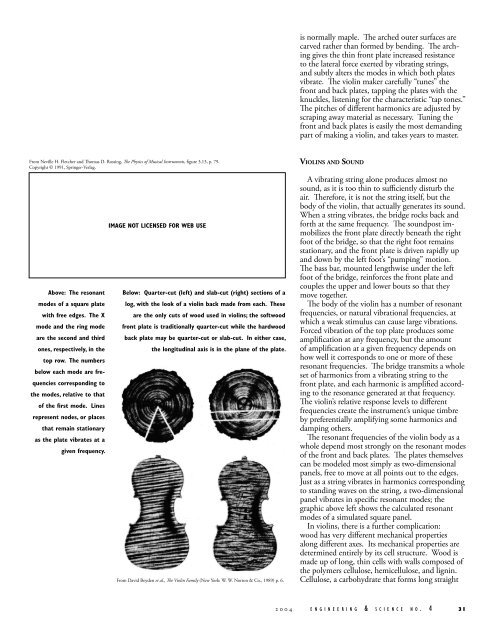Cremona Revisited: The Science of Violin Making - Computer ...
Cremona Revisited: The Science of Violin Making - Computer ...
Cremona Revisited: The Science of Violin Making - Computer ...
Create successful ePaper yourself
Turn your PDF publications into a flip-book with our unique Google optimized e-Paper software.
From Neville H. Fletcher and Thomas D. Rossing, <strong>The</strong> Physics <strong>of</strong> Musical Instruments, figure 3.13, p. 79.<br />
Copyright © 1991, Springer-Verlag.<br />
Above: <strong>The</strong> resonant<br />
modes <strong>of</strong> a square plate<br />
with free edges. <strong>The</strong> X<br />
mode and the ring mode<br />
are the second and third<br />
ones, respectively, in the<br />
top row. <strong>The</strong> numbers<br />
below each mode are fre-<br />
quencies corresponding to<br />
the modes, relative to that<br />
<strong>of</strong> the first mode. Lines<br />
represent nodes, or places<br />
that remain stationary<br />
as the plate vibrates at a<br />
given frequency.<br />
IMAGE NOT LICENSED FOR WEB USE<br />
Below: Quarter-cut (left) and slab-cut (right) sections <strong>of</strong> a<br />
log, with the look <strong>of</strong> a violin back made from each. <strong>The</strong>se<br />
are the only cuts <strong>of</strong> wood used in violins; the s<strong>of</strong>twood<br />
front plate is traditionally quarter-cut while the hardwood<br />
back plate may be quarter-cut or slab-cut. In either case,<br />
the longitudinal axis is in the plane <strong>of</strong> the plate.<br />
From David Boyden et al., <strong>The</strong> <strong>Violin</strong> Family (New York: W. W. Norton & Co., 1989) p. 6.<br />
2 0 0 4<br />
is normally maple. <strong>The</strong> arched outer surfaces are<br />
carved rather than formed by bending. <strong>The</strong> arching<br />
gives the thin front plate increased resistance<br />
to the lateral force exerted by vibrating strings,<br />
and subtly alters the modes in which both plates<br />
vibrate. <strong>The</strong> violin maker carefully “tunes” the<br />
front and back plates, tapping the plates with the<br />
knuckles, listening for the characteristic “tap tones.”<br />
<strong>The</strong> pitches <strong>of</strong> different harmonics are adjusted by<br />
scraping away material as necessary. Tuning the<br />
front and back plates is easily the most demanding<br />
part <strong>of</strong> making a violin, and takes years to master.<br />
VIOLINS AND SOUND<br />
A vibrating string alone produces almost no<br />
sound, as it is too thin to sufficiently disturb the<br />
air. <strong>The</strong>refore, it is not the string itself, but the<br />
body <strong>of</strong> the violin, that actually generates its sound.<br />
When a string vibrates, the bridge rocks back and<br />
forth at the same frequency. <strong>The</strong> soundpost immobilizes<br />
the front plate directly beneath the right<br />
foot <strong>of</strong> the bridge, so that the right foot remains<br />
stationary, and the front plate is driven rapidly up<br />
and down by the left foot’s “pumping” motion.<br />
<strong>The</strong> bass bar, mounted lengthwise under the left<br />
foot <strong>of</strong> the bridge, reinforces the front plate and<br />
couples the upper and lower bouts so that they<br />
move together.<br />
<strong>The</strong> body <strong>of</strong> the violin has a number <strong>of</strong> resonant<br />
frequencies, or natural vibrational frequencies, at<br />
which a weak stimulus can cause large vibrations.<br />
Forced vibration <strong>of</strong> the top plate produces some<br />
amplification at any frequency, but the amount<br />
<strong>of</strong> amplification at a given frequency depends on<br />
how well it corresponds to one or more <strong>of</strong> these<br />
resonant frequencies. <strong>The</strong> bridge transmits a whole<br />
set <strong>of</strong> harmonics from a vibrating string to the<br />
front plate, and each harmonic is amplified according<br />
to the resonance generated at that frequency.<br />
<strong>The</strong> violin’s relative response levels to different<br />
frequencies create the instrument’s unique timbre<br />
by preferentially amplifying some harmonics and<br />
damping others.<br />
<strong>The</strong> resonant frequencies <strong>of</strong> the violin body as a<br />
whole depend most strongly on the resonant modes<br />
<strong>of</strong> the front and back plates. <strong>The</strong> plates themselves<br />
can be modeled most simply as two-dimensional<br />
panels, free to move at all points out to the edges.<br />
Just as a string vibrates in harmonics corresponding<br />
to standing waves on the string, a two-dimensional<br />
panel vibrates in specific resonant modes; the<br />
graphic above left shows the calculated resonant<br />
modes <strong>of</strong> a simulated square panel.<br />
In violins, there is a further complication:<br />
wood has very different mechanical properties<br />
along different axes. Its mechanical properties are<br />
determined entirely by its cell structure. Wood is<br />
made up <strong>of</strong> long, thin cells with walls composed <strong>of</strong><br />
the polymers cellulose, hemicellulose, and lignin.<br />
Cellulose, a carbohydrate that forms long straight<br />
E N G I N E E R I N G & S C I E N C E N O . 4<br />
31


